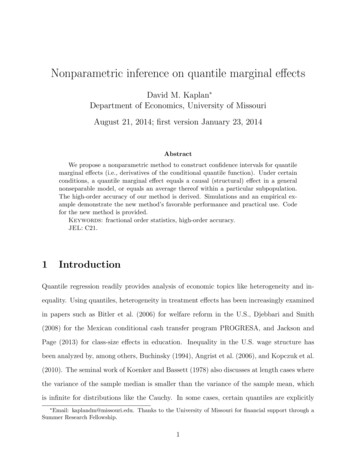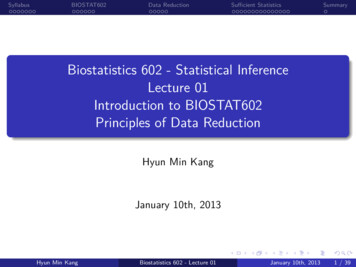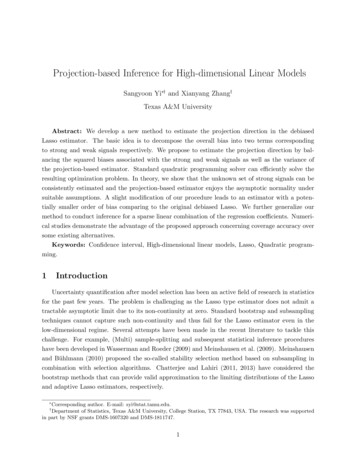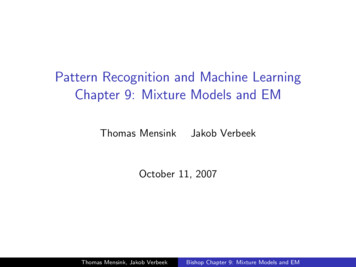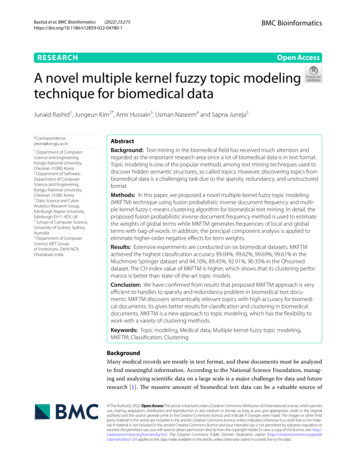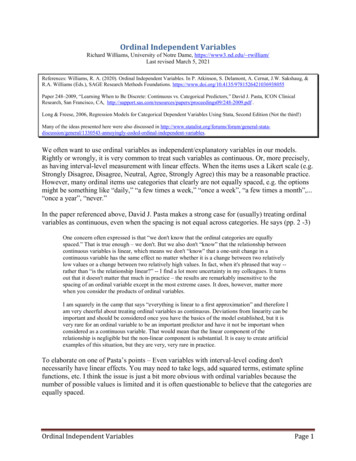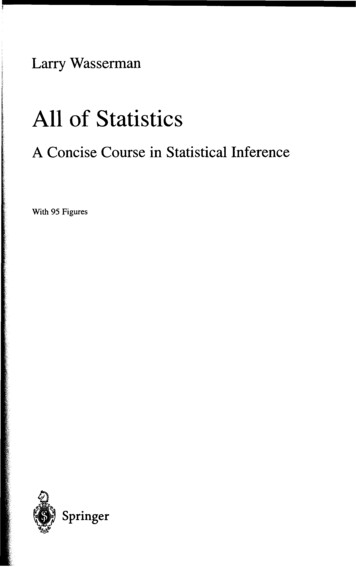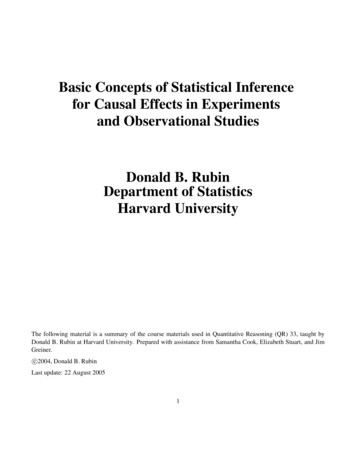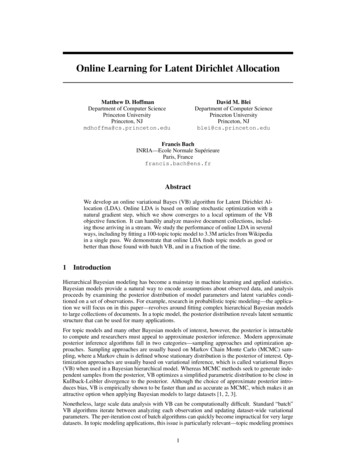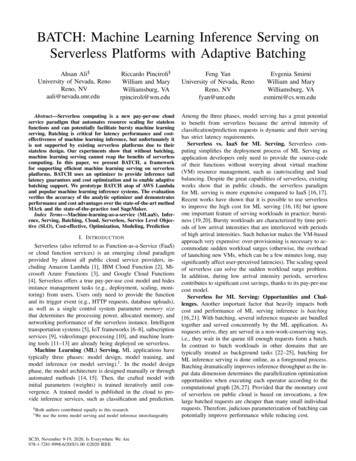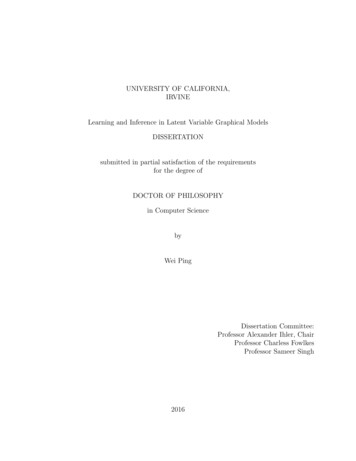
Transcription
UNIVERSITY OF CALIFORNIA,IRVINELearning and Inference in Latent Variable Graphical ModelsDISSERTATIONsubmitted in partial satisfaction of the requirementsfor the degree ofDOCTOR OF PHILOSOPHYin Computer SciencebyWei PingDissertation Committee:Professor Alexander Ihler, ChairProfessor Charless FowlkesProfessor Sameer Singh2016
c 2016 Wei Ping
DEDICATIONTo my grandma,my parents and my honey bunny forever.ii
TABLE OF CONTENTSPageLIST OF FIGURESviLIST OF TABLESviiLIST OF ALGORITHMSviiiACKNOWLEDGMENTSixCURRICULUM VITAExABSTRACT OF THE DISSERTATION1 Introduction1.1 Inference in Graphical Models1.2 Structured Output Learning .1.3 Latent Variable Models . . . .1.4 Outline and Contributions . .xii.2 Background2.1 Graphical Models . . . . . . . . . . . . . . . . . . . . . . . .2.1.1 Markov Random Fields . . . . . . . . . . . . . . . . .2.1.2 Conditional Random Fields . . . . . . . . . . . . . .2.1.3 CRF with Hidden Variables . . . . . . . . . . . . . .2.1.4 Restricted Boltzmann Machine . . . . . . . . . . . .2.1.5 Conditional RBM . . . . . . . . . . . . . . . . . . . .2.2 Inference Tasks . . . . . . . . . . . . . . . . . . . . . . . . .2.2.1 Marginalization Inference . . . . . . . . . . . . . . .2.2.2 MAP Inference . . . . . . . . . . . . . . . . . . . . .2.2.3 Marginal MAP . . . . . . . . . . . . . . . . . . . . .2.2.4 A Unified Inference Framework . . . . . . . . . . . .2.3 Approximate Inference and Variational Methods . . . . . . .2.3.1 Exponential Family and Exact Variational Form . . .2.3.2 Loopy Belief Propagation and Bethe Approximation .2.3.3 Tree-reweighted Variational Method . . . . . . . . . .2.3.4 Dual Decomposition for MAP . . . . . . . . . . . . .2.4 Learning Methods . . . . . . . . . . . . . . . . . . . . . . . .2.4.1 MLE for Graphical Models . . . . . . . . . . . . . . .2.4.2 Structured SVM . . . . . . . . . . . . . . . . . . . 1
3 Dual-decomposition Bounds for Marginal MAP3.1 Introduction . . . . . . . . . . . . . . . . . . . . . . . .3.2 State of the Art . . . . . . . . . . . . . . . . . . . . . .3.3 Fully Decomposed Upper Bound . . . . . . . . . . . . .3.3.1 Including Cost-shifting Variables . . . . . . . .3.3.2 Variational Form and Connection With Existing3.4 Monotonically Tightening the Bound . . . . . . . . . .3.4.1 Moment Matching and Entropy Matching . . .3.4.2 Block Coordinate Descent . . . . . . . . . . . .3.5 Extensions to Junction Graph . . . . . . . . . . . . . .3.6 Experiments . . . . . . . . . . . . . . . . . . . . . . . .3.6.1 Ising Model . . . . . . . . . . . . . . . . . . . .3.6.2 UAI Inference Challenges . . . . . . . . . . . .3.7 Conclusion . . . . . . . . . . . . . . . . . . . . . . . . . . . . . . . . . . . . . . . . .Bounds. . . . . . . . . . . . . . . . . . . . . . . . . . . . . . . . .44444649505154555659606061654 Marginal Structured SVM4.1 Introduction . . . . . . . . . . . . . . . . . .4.2 Related Work . . . . . . . . . . . . . . . . .4.3 Structured Prediction with Hidden Variables4.4 Marginal Structured SVM . . . . . . . . . .4.5 A Unified Framework . . . . . . . . . . . . .4.6 Training Algorithms . . . . . . . . . . . . .4.6.1 Sub-gradient Descent . . . . . . . . .4.6.2 CCCP Training Algorithm . . . . . .4.7 Experiments . . . . . . . . . . . . . . . . . .4.7.1 Simulated Data . . . . . . . . . . . .4.7.2 Image Segmentation . . . . . . . . .4.7.3 Object Categorization . . . . . . . .4.8 Conclusion . . . . . . . . . . . . . . . . . . 03Prediction. . . . . . . . . . . . . . . . . . . . . . . . . . . .104105107108.5 Learning Infinite RBMs with Frank-Wolfe5.1 Introduction . . . . . . . . . . . . . . . . . . . . .5.2 Related Work . . . . . . . . . . . . . . . . . . . .5.3 Background and Notations . . . . . . . . . . . . .5.4 RBM with Infinite Hidden Units . . . . . . . . . .5.4.1 Model Definition . . . . . . . . . . . . . .5.4.2 Learning Infinite RBMs with Frank-Wolfe5.4.3 MCMC Inference for Fractional RBMs . .5.5 Experiments . . . . . . . . . . . . . . . . . . . . .5.6 Conclusion . . . . . . . . . . . . . . . . . . . . . .6 Belief Propagation in Conditional RBMs for Structured6.1 Introduction . . . . . . . . . . . . . . . . . . . . . . . . . .6.2 Related Work . . . . . . . . . . . . . . . . . . . . . . . . .6.3 Background and Notations . . . . . . . . . . . . . . . . . .iv.
6.46.56.66.76.3.1 Structured Prediction with CRBMsLearning with CRBMs . . . . . . . . . . .6.4.1 MLE and Related Algorithms . . .6.4.2 Max-Margin Learning . . . . . . .Approximate Inference in RBM . . . . . .6.5.1 Message-passing in RBMs . . . . .6.5.2 Matrix-based BP ImplementationsExperiments . . . . . . . . . . . . . . . . .Conclusions and Future Work . . . . . . .1091101101121131131151191247 Conclusions and Future Directions126Bibliography128A Derivations and Proofs for Dual-Decomposition BoundsA.1 Dual Representations . . . . . . . . . . . . . . . . . . . . .A.1.1 Proof of Thereom 4.2 . . . . . . . . . . . . . . . . .A.1.2 Matching Our Bound to WMB . . . . . . . . . . .A.2 Proof of Therom 5.1 . . . . . . . . . . . . . . . . . . . . .A.3 Derivations of Gradient . . . . . . . . . . . . . . . . . . . .A.4 Derivation of Hessian . . . . . . . . . . . . . . . . . . . . .A.5 Derivations of Closed-form Update . . . . . . . . . . . . .135135135137138140142146B Derivations and Proofs for Marginal Structured SVM150B.1 Properties of Unified Framework . . . . . . . . . . . . . . . . . . . . . . . . . 150C Derivations and Proofs for Conditional RBMs153C.1 Derivation of Matrix-based BP . . . . . . . . . . . . . . . . . . . . . . . . . 153v
LIST OF FIGURESPage1.11.2Example of image semantic segmentation. . . . . . . . . . . . . . . . . . . .Example of image segmentation with partially labeled data. . . . . . . . . .452.12.22.3Graphical illustration of the chain-structured CRF and grid-structured CRF.Graphical illustration of the CRF with hidden variables. . . . . . . . . . . .Graphical illustration of the RBM and conditional RBM. . . . . . . . . . . .1314173.1Illustration of weighted mini-bucket (WMB), tree-reweighted BP (TRW) andour dual-decomposition bounds on grid model. . . . . . . . . . . . . . . . .Sum-inference and marginal MAP results on a toy Ising model. . . . . . . . .Marginal MAP results on two diagnostic Bayesian networks with 50% randomly selected max-nodes . . . . . . . . . . . . . . . . . . . . . . . . . . . .More inference results on two diagnostic Bayesian networks with various percentages of randomly selected max-nodes. . . . . . . . . . . . . . . . . . . . .Marginal MAP results on pedigree linkage analysis models. . . . . . . . . . .3.23.33.43.54.14.24.34.44.54.6The hidden chain and grid model in simulation experiments. . . . . . . . . .Convergence behaviours of (sub-)gradient descent on MSSVMs, LSSVMs andHCRFs. . . . . . . . . . . . . . . . . . . . . . . . . . . . . . . . . . . . . . .The error rate of MSSVM, LSSVM and HCRFs as the training sample sizeincreases. . . . . . . . . . . . . . . . . . . . . . . . . . . . . . . . . . . . . .The test log-likelihood of MSSVM, LSSVM and HCRF. . . . . . . . . . . . .The performance of different methods on image segmentation with variouspercentages of missing labels. . . . . . . . . . . . . . . . . . . . . . . . . . .Example images from MSRC dataset. . . . . . . . . . . . . . . . . . . . . . .53616363648081828385865.15.2Average test log-likelihood of learned RBMs on MNIST and Caltech101. . . 103Classification error when using hidden representations learned by Frank-Wolfeand CD algorithm. . . . . . . . . . . . . . . . . . . . . . . . . . . . . . . . . 1036.16.2Examples of image denoising and completion on MNIST. . . . . . . . . . . . 121Convergence behaviour of belief propagation in maximum likelihood training. 124vi
LIST OF TABLESPage4.14.24.34.46.16.26.3Model comparisons within our unified framework. . . . . . . . . . . . . . . .Average accuracy of MSSVM, LSSVM, HCRFs using SGD and CCCP onsimulated data. . . . . . . . . . . . . . . . . . . . . . . . . . . . . . . . . . .The accuracy of MSSVM, LSSVM, HCRF, M3E and ModLat under differentlevel of uncertainty in the hidden variables. . . . . . . . . . . . . . . . . . . .Average patch level accuracy of MSSVM, LSSVM, HCRFs for MSRC data. .74808486Average test error for image denoising on MINIST. . . . . . . . . . . . . . . 122Average test error for image completion on MINIST. . . . . . . . . . . . . . 122Average test error for image denoising & completion on Caltech101 Silhouettesdataset. . . . . . . . . . . . . . . . . . . . . . . . . . . . . . . . . . . . . . . 123vii
LIST OF ALGORITHMSPage2.13.14.14.25.16.16.2Loopy Belief Propagation on Pairwise ModelsGeneralized Dual-decomposition (GDD) . . .Sub-gradient Descent for MSSVM . . . . . . .CCCP Training of MSSVM . . . . . . . . . .Frank-Wolfe Learning Algorithm . . . . . . . .Sum-product BP on RBM . . . . . . . . . . .Mixed-product BP on RBM . . . . . . . . . .viii. 30. 56. 76. 78. 98. 118. 119
ACKNOWLEDGMENTSFirst and foremost, I want to thank my amazing advisor Prof. Alexander Ihler. He is thebest advisor I can ever imagine. He points out important research directions for me whenI started to do research with him. He can instantly point out the logical fallacies in mythoughts and give insightful suggestions at the same time. He always encourages me to dothe best, and he is always supportive when I need him most. I really appreciate him inthese years. For this thesis, Alex have devoted a lot of time to read and edit my draft wordby word. Due to my extreme procrastination of finishing the draft, he even gave up hisThanksgiving holidays, appeared at the office in a rainy Saturday and discussed with meabout the problems in my draft. I am just so lucky and honoured to be his student.I would like to thank the two other members of my committee – Prof. Charless Fowlkes andProf. Sameer Singh. Charless is also on my advancement committee and gives me a lot ofconstructive suggestions for my research, especially for future directions. I met Sameer andwe have lunch together when he visit UCI at the first time. He is very insightful on analysingthe new ideas from various perspectives, and always gives inspired comments. In particular,I really appreciate him for saving me at the last minute.I would also like to thank my peers and collaborators. In particular, I want to thank QiangLiu who guided me into the area of graphical models, and always gives me constructivesuggestions when I encounter difficulties in research. Thanks to Qi Lou who spent hugeamount of time with me at DBH 4051. Also, thanks to Nick Gallo for all those refreshingdiscussions on various topics. I would like to thank all my close friends Mengfan Tang, YiLi, Yuxiao Wang, Qiguang Wang and Zhengqiu Huang. I will never forget those nights whenwe are dead drunk. There are so many names I want to mention, so I will simply thank allmy friends over the years.Most importantly, I would like to thank my parents for their unconditional love at any timeat any situation. Finally, I want thank my honey bunny Lingjie Weng without whom I couldnever make it to the end.My graduate work and this thesis have been supported by NSF grants IIS-1065618 andIIS-1254071.ix
CURRICULUM VITAEWei PingEDUCATIONDoctor of Philosophy in Computer ScienceUniversity of California, Irvine2016Irvine, CaliforniaMaster of Software EngineeringTsinghua University2011ChinaBachelor of Computer ScienceHarbin Institute of Technology2008ChinaRESEARCH EXPERIENCEGraduate Research AssistantUniversity of California, Irvine2011–2016Irvine, CaliforniaResearch InternMicrosoft Research Asia08/2009 – 02/2011Beijing, ChinaACADEMIC REVIEWINGIEEE Transactions on Pattern Analysis and Machine Intelligence (TPAMI)IEEE Transactions on Signal processingConference on Neural Information Processing Systems (NIPS)Conference on Uncertainty in Artificial Intelligence (UAI)AAAI Conference on Artificial Intelligence (AAAI)2015-20162016201620162015PUBLICATIONSW. Ping, A. Ihler. Belief Propagation in Conditional RBMs for Structured Prediction. InSubmission, 2016.W. Ping, Q. Liu, A. Ihler. Learning Infinite RBMs with Frank-Wolfe. Neural InformationProcessing Systems (NIPS) , 2016.W. Ping, Q. Liu, A. Ihler. Decomposition Bounds for Marginal MAP. Neural InformationProcessing Systems (NIPS) , 2015.W. Ping, Q. Liu, A. Ihler. Marginal structured SVM with hidden variables. InternationalConference on Machine Learning (ICML), 2014.x
Y. Xu, W. Ping, A.T. Campbell. Multi-instance Metric Learning. IEEE InternationalConference on Data Mining (ICDM), 2011.W. Ping, Y. Xu, A.T. Campbell. FAMER: Making Multi-Instance Learning Better andFaster. SIAM International Conference on Data Mining (SDM), 2011.Y. Xu, Furao Shen, W. Ping, Jinxi Zhao. TAKES: a Fast Method to Select Features in theKernel Space. ACM International Conference on Information and Knowledge Management(CIKM), 2011.Y. Cai, L. Yang, W. Ping, F. Wang, T. Mei, X.S. Hua, S. Li. Million-scale Near-duplicateVideo Retrieval System. ACM International Conference on Multimedia (MM), 2011.W. Ping, Y. Xu, K. Ren, C.H. Chi, F. Shen. Non-I.I.D. Multi-Instance DimensionalityReduction by Learning a Maximum Bag Margin Subspace AAAI Conference on ArtificialIntelligence (AAAI), 2010.xi
ABSTRACT OF THE DISSERTATIONLearning and Inference in Latent Variable Graphical ModelsByWei PingDoctor of Philosophy in Computer ScienceUniversity of California, Irvine, 2016Professor Alexander Ihler, ChairProbabilistic graphical models such as Markov random fields provide a powerful frameworkand tools for machine learning, especially for structured output learning. Latent variablesnaturally exist in many applications of these models; they may arise from partially labeleddata, or be introduced to enrich model flexibility. However, the presence of latent variablespresents challenges for learning and inference.For example, the standard approach of using maximum a posteriori (MAP) prediction iscomplicated by the fact that, in latent variable models (LVMs), we typically want to firstmarginalize out the latent variables, leading to an inference task called marginal MAP. Unfortunately, marginal MAP prediction can be NP-hard even on relatively simple models suchas trees, and few methods have been developed in the literature. This thesis presents a classof variational bounds for marginal MAP that generalizes the popular dual-decompositionmethod for MAP inference, and enables an efficient block coordinate descent algorithm tosolve the corresponding optimization. Similarly, when learning LVMs for structured prediction, it is critically important to maintain the effect of uncertainty over latent variablesby marginalization. We propose the marginal structured SVM, which uses marginal MAPinference to properly handle that uncertainty inside the framework of max-margin learning.xii
We then turn our attention to an important subclass of latent variable models, restrictedBoltzmann machines (RBMs). RBMs are two-layer latent variable models that are widelyused to capture complex distributions of observed data, including as building block fordeep probabilistic models. One practical problem in RBMs is model selection: we need todetermine the hidden (latent) layer size before performing learning. We propose an infiniteRBM model and apply the Frank-Wolfe algorithm to solve the resulting learning problem.The resulting algorithm can be interpreted as inserting a hidden variable into a RBM modelat each iteration, to easily and efficiently perform model selection during learning. We alsostudy the role of approximate inference in RBMs and conditional RBMs. In particular, thereis a common assumption that belief propagation methods do not work well on RBM-basedmodels, especially for learning. In contrast, we demonstrate that for conditional models andstructured prediction, learning RBM-based models with belief propagation and its variantscan provide much better results than the state-of-the-art contrastive divergence methods.xiii
Chapter 1IntroductionProbabilistic approaches play central roles in modern developments and analyses of machinelearning methods [e.g., Murphy, 2012, Friedman et al., 2001]. Among all probabilistic techniques, probabilistic graphical models, such as Markov random fields (MRFs) and Bayesiannetworks, provide a unified framework and powerful computation tools for probabilistic modeling. In real-world modeling applications, a large part of useful graphical models are latentvariable models (LVMs). This is mainly because (1) partially labeled data or missing values widely exist in practice, and (2) latent variables have been widely used to capture thecomplex high-order correlations among observable data. The presence of latent variablespresents challenges for learning, inference and model selection. In this chapter, we give anoverview of the topics and methodologies that are covered in this thesis.1.1 Inference in Graphical ModelsA graphical model defines a probability distribution over a set of random variables, which usesa graph-based representation to encode the relationships among variables (i.e, conditionalindependences) and organize the required computation. Given a graphical model, inferencerefers to answering probabilistic queries about the model. There are three common types ofinference tasks. The first are max-inference or maximum a posteriori (MAP) tasks, which1
aim to find the most probable state of the joint probability; exact and approximate MAPinference is widely used in structured prediction, as we will discuss later. Sum-inference tasksinclude calculating marginal probabilities and the normalization constant of the distribution,and play a central role in many learning tasks (e.g., maximum likelihood estimation ofMRFs). Finally, marginal MAP tasks naturally arise in latent variable models (LVMs) [e.g.,Ping et al., 2014, Naradowsky et al., 2012], in which one need to find the optimal MAPprediction or estimation with latent variables marginalized. They are “mixed” inferenceproblems, which generalize the first two types by marginalizing a subset of variables (i.e.,latent variables) before optimizing over the remainder.1All three inference types aregenerally intractable but marginal MAP is more challenging on both theoretical and practicalside; the computational complexity of marginal MAP is NPPP -complete [Park and Darwiche,2004], which is believed to be harder than MAP inference (NP-hard) and sum-inference (#Pcomplete), and marginal MAP tasks can be intractable even on tree structured model. As aresult, approximate inference, particularly convex relaxations or upper bounding methods,are of great interest.Dual decomposition methods for MAP [e.g., Sontag et al., 2011] give a class of fully decomposed upper bounds which can be directly optimized using coordinate descent algorithms [e.g., Werner, 2007, Globerson and Jaakkola, 2008]. It is easy to ensure both convergence, and that the objective is monotonically decreasing (so that more computation alwaysprovides a better bound). Given these desirable properties, it is of great interest to investigate dual decomposition methods for other inference tasks. In particular, marginal MAP issignificantly more difficult than MAP and pure marginalization task, and far fewer methodshave been developed. In this thesis, we propose a full decomposition bound which is applicable for both marginal inference and marginal MAP inference. We derive block coordinatedescent algorithm which ensures convergence and monotonicity.1In some literature [e.g., Park and Darwiche, 2004], marginal MAP is simply called MAP, and the jointMAP task is called MPE.2
1.2 Structured Output LearningStructured output learning or structured prediction is one of the most important applicationdomain of graphical models in machine learning, where one need predict a set of correlatedvariables. In specific, one need to learn a structured predictor f : x y using some trainingdata {xn , y n }Nn 1 , while both the mapping between input-output pair (x, y) and correlationsamong the output variables are modeled by a probabilistic graphical model. For example,in semantic segmentation task from computer vision, given an input image x, we need toclassify each pixel as a semantic category. The semantic labels y of these pixels are highlycorrelated, so we need to make joint predictions. See Figure 1.1(a)-(b) for an example fromMicrosoft Research Cambridge (MSRC) dataset [Winn et al., 2005]. In part-of-speech (POS)tagging from natural language processing, given a sequence of words, one need to classifyeach word into a particular POS, and those POS tags are also highly correlated.Conditional random fields (CRFs) [Lafferty et al., 2001] and structured support vector machines (SSVMs) [Taskar et al., 2003, Tsochantaridis et al., 2005] are standard tools forstructured prediction in many important domains, such as computer vision [Nowozin andLampert, 2011], natural language processing [Getoor and Taskar, 2007] and computationalbiology [e.g., Li et al., 2007, Sato and Sakakibara, 2005]. See Figure 1.1(c) for an illustrationof the popular CRF model for image segmentation, which explicitly encodes the correlationsamong the pixels through the grid structure. However, many practical cases are not wellhandled by these tools, due to the presence of latent variables. We will discuss the latentvariable problem in next section.3
(a) input image x(b) pixel-wise labellings y(c) grid structured CRFFigure 1.1: (a) An example image from MSRC dataset. (b) Pixel-wise labellings includingsky, grass and tree. (c) Grid structured CRF in which the hatching nodes x represent inputfeatures, and white nodes y represent output variables.1.3 Latent Variable ModelsLatent variables exist in many practical applications of graphical models. They may comefrom the missing information of partially labeled data; in previous image segmentation example, while it is really expensive to collect labels for every single pixel, especially for boundariesof objects and ambiguous regions (see Figure 1.2(a)-(b) for an example), partially labeleddata are relatively easy to obtain [e.g., Verbeek and Triggs, 2007]. On the other hand, latentvariables are very important for modeling purpose, because they can either capture the highorder correlations between the observed variables, or they directly represent some importantlatent/unobserved factors in real world.LVMs for Structured Prediction. Many latent variable models (LVMs), such as hiddenconditional random fields [e.g., Quattoni et al., 2007b], have been proposed for structuredprediction. See Figure 1.2(c) for an illustration of CRF with hidden variables h.Latent structured SVMs (LSSVMs) [Yu and Joachims, 2009a], which are extended fromstructured SVMs [Taskar et al., 2003, Tsochantaridis et al., 2005], are among the mostpopular learning methods for these models. It often outperforms its counterparts in manypractical applications, especially when the model assumptions are violated or the numberof training data is limited [e.g., Taskar et al., 2003]. However, LSSVM relies on a joint4
(a) input image x(b) pixel-wise labellings y(c) CRF with hidden variables hFigure 1.2: (a) An example image from MSRC dataset. (b) Pixel-wise labellings includingcow, grass and tree. The black region represents missing labels. (c) CRF with hiddenvariables (shaded nodes) representing missing labels.maximum a posteriori (MAP) inference which assigns the latent variables h to deterministicvalues, and does not take into account their uncertainty. It can produce poor predictionsof output variables y even for exact models [Liu and Ihler, 2013] at test phase, and doesnot maintain the uncertainty of latent variables during learning. A better approach forprediction is marginal MAP inference that averages over possible states of latent variablesbefore optimizing over output variables. In this thesis, we propose a marginal structuredSVM framework, which properly accounts for the uncertainty of latent variables duringlearning by incorporating the marginal MAP inference into the max-margin paradigm.Restricted Boltzmann Machines. Another popular class of latent variable models arerestricted Boltzmann machines (RBMs). RBMs are two-layer models that use a layer ofhidden variables to model the distribution of observable variables [Smolensky, 1986, Hinton,2002b]. In the literature on RBMs, hidden and observable variables are referred to as hiddenunits h and visible units v, respectively. RBMs have been widely used to capture complexdistributions in numerous application domains, including image modeling [Krizhevsky et al.,2010], human motion capture [Taylor et al., 2006b] and collaborative filtering [Salakhutdinovet al., 2007b], and are also widely used as building blocks for deep generative models, suchas deep belief networks [Hinton et al., 2006b] and deep Boltzmann machines [Salakhutdinovand Hinton, 2009]. Due to the intractability of the likelihood function, RBMs are usuallylearned using the contrastive divergence (CD) algorithm [Hinton, 2002b, Tieleman, 2008],5
which approximates the gradient of the likelihood using a Gibbs sampler.An important model selection problem for RBM is that we need to determine the size of thehidden layer (number of hidden units), and it is challenging to decide what is the optimalsize. One heuristic is to search the “best” size of hidden layer using cross validation ortesting likelihood within a pre-defined candidate set. Unfortunately, this is extremely timeconsuming; it involves running a full training algorithm (e.g., CD) for each possible size, andthus we can only search over a relatively small set of sizes using this approach. In this thesis,we propose an infinite RBM model, whose maximum likelihood estimation (MLE) can besolved by an efficient, greedy algorithm by inserting one hidden unit at each iteration. Thiscan be used to easily identify an appropriate number of hidden units during learning.Conditional RBM A conditional restricted Boltzmann machine (CRBM) is the discriminative extension of RBM to include observed features x; CRBM is used in deep probabilisticmodel for supervised learning [Hinton et al., 2006a], and also provides a stand-alone solution to a wide range of problems such as classification [Larochelle and Bengio, 2008], humanmotion capture [Taylor et al., 2006a], collaborative filtering [Salakhutdinov et al., 2007a],and structured prediction [Mnih et al., 2011, Yang et al., 2014]. For structured prediction,a CRBM need not make any explicit assumptions about the structure of the output variables (visible units v). This is especially useful in many applications where the structureof the outputs is challenging to describe (e.g., multi-label learning [Li et al., 2015]). In image denoising or object segmentation, the hidden units can encode higher-order correlationsof visible units (e.g. shapes, or parts of object), which play the same role as high-orderpotentials but can improve the statistical efficiency.Loopy belief propagation (BP) [Pearl, 1988] is a very popular approximate inference algorithm and usually provides a good approximation of marginals for loopy graphical model. Itcan be used as inference routine in learning as well as for making predictions after the CRBM6
has been learned. However, it was found to be slow on CRBMs for structured predictionand only considered practical on problems with relatively few visible and hidden units [Mnihet al., 2011]. More importantly, there is a pervasive opinion that belief propagation does notwork well on RBM-based models, especially for learning [Goodfellow et al., 2016, Chapter16]. In this thesis, we present a very efficient implementation of BP, and demonstrate thattraining conditional RBMs with BP as the inference routine can provide significantly betterresults than current state-of-the-art algorithms.1.4 Outline and ContributionsThe general outline and contributions of this thesis are summarized as follows:Chapter 3 generalizes dual decomposition to a generic power sum inference task, whichincludes marginal MAP, along with pure marginalization and MAP, as special cases. Specificcontributions include: We propose a new convex decomposition bound, which is fully decomposed over theindividual cliques of graph. Based on the full decomposition, we develop a block coordinate descent algorithmwhich is guaranteed to converge monotonically, and can be parallelized efficiently. Our method is faster and more reliable than previous methods on various inferencequeries defined on real-world problems from the UAI approximate inference challenge.This Chapter is based the work originally published in Ping et al. [2015].Chapter 4 proposes the marginal structured SVM (MSSVM) for structure
Wei Ping EDUCATION Doctor of Philosophy in Computer Science 2016 University of California, Irvine Irvine, California Master of Software Engineering 2011 Tsinghua University China Bachelor of Computer Science 2008 Harbin Institute of Technology China RESEARCH EXPERIENCE Graduate Research Assistant 2011{2016 University of California, Irvine .

